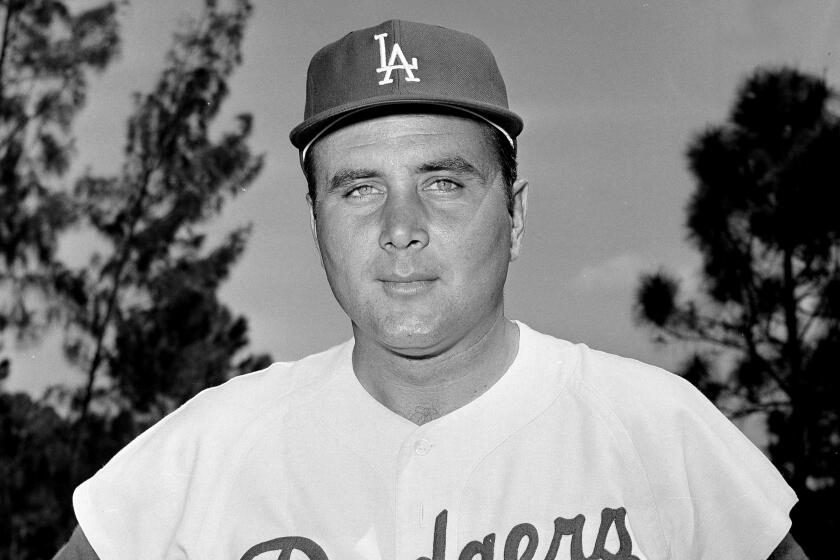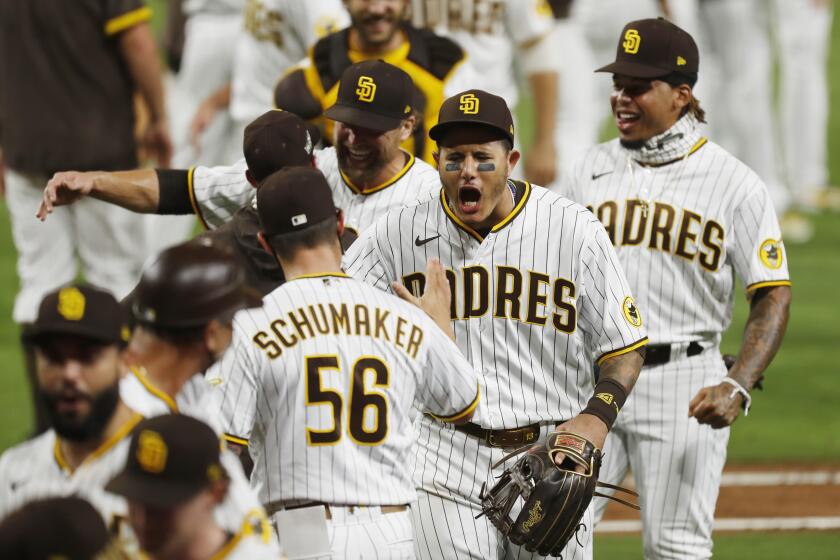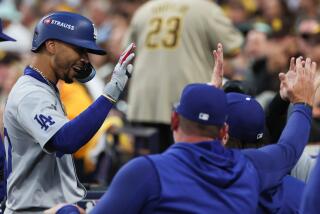Mookie Betts is a Dodgers difference-maker now and for a long time
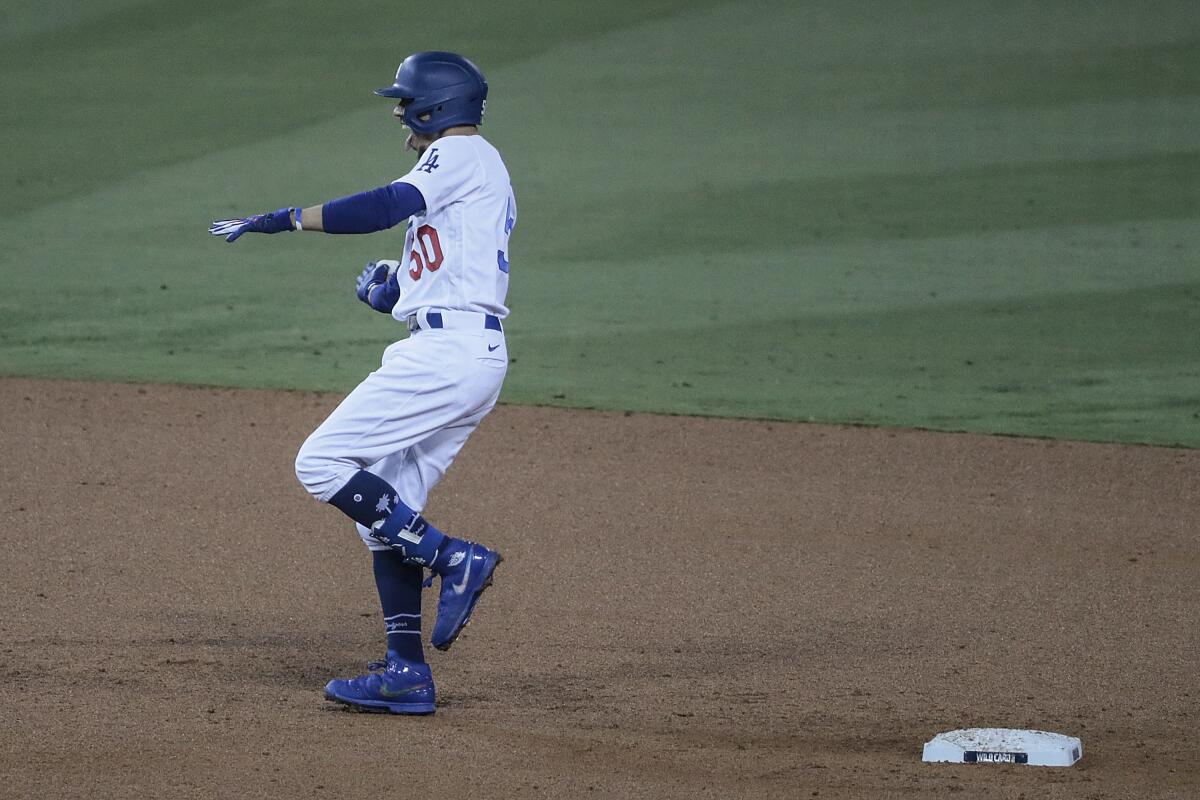
- Share via
The Dodgers acquired Mookie Betts in February and committed $365 million to him in July for one reason above all: To put them over the top in October. They wanted him for the kind of game-changing playoff moment he delivered in the fifth inning against the Milwaukee Brewers on Thursday.
Betts had never faced Brandon Woodruff, a hard-throwing right-hander, before Game 2 of the National League wild-card series. The first two encounters were one-sided.
Betts struck out trying to check his swing on a 97-mph fastball up and out of the strike zone in the first inning. He didn’t even bother waiting to see the first base umpire’s ruling on the appeal. He knew he committed.
In his second at-bat, Woodruff fooled Betts with an 85-mph changeup that dove back over the outer half of the plate for strike three looking to end the third inning. Betts walked to the dugout without protest. He was again soundly defeated. The strikeouts were two of the eight Woodruff accumulated in the first four innings.
“He’s obviously one of the best of the best,” Betts said. “What he was doing, he pitched amazing.”
Ron Perranoski, the left-handed ace of the Dodgers’ bullpen who helped them win a pair of World Series championships in the 1960s, has died.
The circumstances were different when Betts stepped into the batter’s box for a third time against Woodruff in the fifth inning. The Dodgers, preying on the Brewers’ inability to turn an inning-ending double play, had manufactured a run with two outs on an RBI groundball single up the middle from Austin Barnes to lead 1-0.
The Brewers gave them an opening. It was on Betts, working with intel from the first two at-bats, to make sure the Dodgers further capitalized with two on and two out.
Betts took the first two pitches outside to jump ahead. With Corey Seager on deck, the pressure was on Woodruff to walk the line between throwing a strike and not offering Betts a pitch to drive. He tripped.
The next pitch was a 96-mph sinker that darted over the middle. Betts turned on it and clobbered a line drive down the left-field line. Two runs scored. Betts raced to second for his third double in two nights. The Dodgers went ahead 3-0 — a lead that held thanks to Clayton Kershaw’s dominant eight-inning pitching performance — and advanced to the NL Division Series.
“Mookie just has a way of staying in the moment, seeing the pitch, getting a good pitch to hit,” Dodgers manager Dave Roberts said. “To add a couple insurance runs on that double was huge for us, a little breathing room for Clayton. It certainly makes us all better when he’s in the lineup.”
Betts’s initial place in the Dodgers’ lineup raised eyebrows. Despite communicating his preference to hit leadoff, Betts batted second on opening day.
The Dodgers and Padres might have been the best teams in the National League during the regular season, and now they meet in the NLDS in Arlington, Texas.
He flipped between first and second for the season’s first three weeks depending on the opposing starting pitcher’s handedness. He was the leadoff man against left-handers and batted second against righties. The Dodgers were experimenting with eyes on October.
But the Dodgers’ alternatives in the leadoff spot struggled and Betts batted leadoff against a right-hander for the first time Aug. 13. He went four for four with three home runs in an 11-2 win over the San Diego Padres and he stayed there.
“I think it’s just more comfortable in the leadoff spot, knowing I don’t have to look at the lineup,” the 27-year-old Betts said. “I know where I’m hitting and where I’m playing. That was just a comfort thing.”
The Dodgers went 31-10 to finish the regular season upon the switch. Betts finished the season with a .302 batting average, 13 home runs and a .952 on-base-plus-slugging percentage in the spot he covets, cementing himself as an NL MVP contender.
He supplies plus defense and baserunning. Off the field, he continues to establish himself as a leader. He gives teammates pointers. His work ethic resonates with peers. He operates with reassuring tranquility. He expects to win and teammates absorb the confidence.
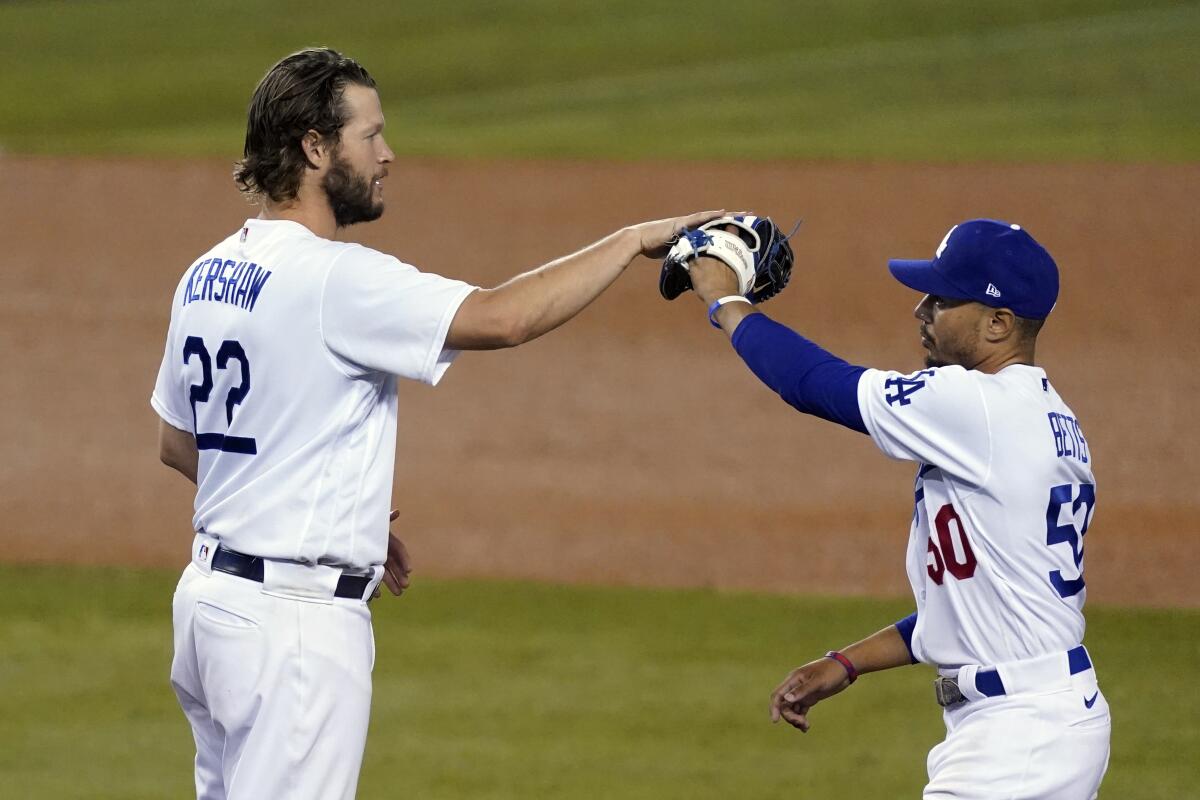
“Mookie kind of separates himself, I feel like, with the consistency,” Kershaw said. “And then the other things he can do on the baseball field if he happens to not be getting hits — that’s what separates him. And there’s also confidence there, just a really calming influence, I think.”
On Thursday, he calmed any nerves with one swing. It was one of many game-changing moments the Dodgers envision Betts producing this postseason and for a long time. He’s the superstar talent they sought to push them to that elusive championship. Two games into the postseason, he’s already delivered.
“Thankfully,” Kershaw said, “he’s on our team.”
More to Read
Are you a true-blue fan?
Get our Dodgers Dugout newsletter for insights, news and much more.
You may occasionally receive promotional content from the Los Angeles Times.

